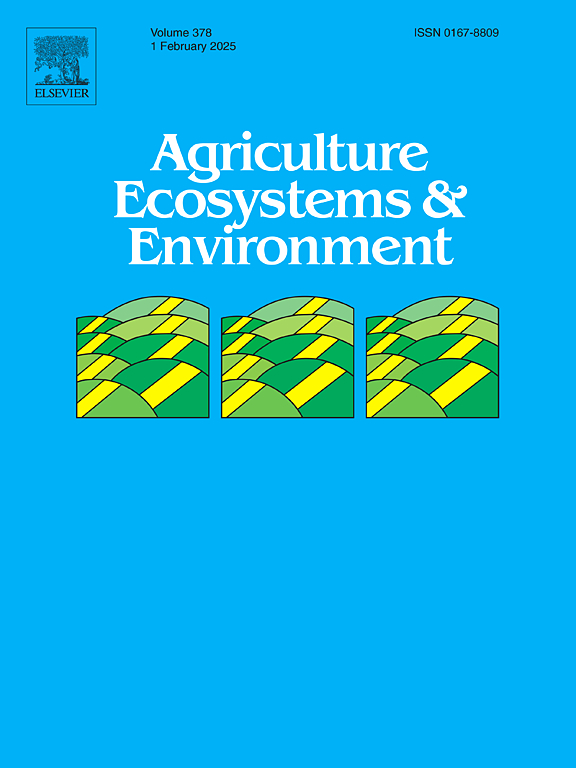Functional groups of leaf phenology are key to build climate-resilience in cocoa agroforestry systems
IF 6
1区 农林科学
Q1 AGRICULTURE, MULTIDISCIPLINARY
引用次数: 0
Abstract
Agroforestry has the potential to enhance climate change adaptation. While benefits from agroforestry systems consisting of cash crops and shade trees are usually attributed to the (shade) trees, the trees can also have negative impacts due to resource competition with crops. Our hypothesis is that leaf phenology and height of shade trees determine their seasonal effect on crops. We test this hypothesis by categorizing shade tree species into functional groups based on leaf phenology, shade tree canopy height and shade tree light (wet and dry season) interception as well as the effects. To this end, leaf phenology and the effects on microclimate (temperature, air humidity, intercepted photoactive radiation (PAR)), soil water, stomatal conductance and cocoa yield were monitored monthly during wet and dry seasons over a two-year period on smallholder cocoa plantations in the northern cocoa belt of Ghana. Seven leaf phenological groups were identified. In the wet season, highest buffering effect of microclimate was recorded under the trees brevi-deciduous before dry season. During dry season, high PAR and lowest reduction in soil moisture were observed under the trees in the group of completely deciduous during dry season. The evergreen groups also showed less reduction in soil water than the brevi-deciduous groups. In the wet season, shade tree effects on cocoa tree yields in their sub canopy compared to the respective control of outer canopy with full sun ranged from positive (+10 %) to negative (-15 %) for the deciduous groups, while yield reductions for the evergreen groups ranged from −20 % to −33 %. While there were negative yield impacts for all phenological groups in the dry season, the trees in completely deciduous during dry season group recorded least penalties (-12 %) and the trees with evergreen upper canopy the highest (-35 %). The function of shade trees in enhancing climate resilience is therefore strongly dependent on their leaf phenological characteristics. Our study demonstrates how the key trait leaf phenology can be applied to successful design of climate-resilient agroforestry systems.
叶片物候功能组是可可农林系统建立气候适应能力的关键
农林业具有增强气候变化适应能力的潜力。虽然由经济作物和遮荫树组成的农林系统的效益通常归功于(遮荫)树,但树木也可能因与作物争夺资源而产生负面影响。我们的假设是,遮荫树的叶片物候和高度决定了它们对农作物的季节性影响。我们根据叶片物候学、遮荫树冠高和遮荫树(雨季和旱季)截光率以及影响,将遮荫树种分为功能组,以此来验证这一假设。为此,在加纳北部可可带的小农可可种植园中,在为期两年的雨季和旱季期间,每月监测叶片物候及其对小气候(温度、空气湿度、截获的光辐射(PAR))、土壤水分、气孔导度和可可产量的影响。确定了七个叶片物候组。在雨季,干季之前的落叶乔木对小气候的缓冲作用最大。在旱季,完全落叶树种的 PAR 值高,土壤水分减少最少。常绿树种组的土壤水分减少率也低于半落叶树种组。在湿季,与外层树冠阳光充足的对照组相比,遮荫树对可可树下层树冠的产量影响从落叶组的正影响(+10%)到负影响(-15%)不等,而常绿组的减产幅度则从-20%到-33%不等。虽然旱季对所有物候组的产量都有负面影响,但旱季完全落叶组树木的减产幅度最小(-12%),而上部树冠为常绿植物的树木的减产幅度最大(-35%)。因此,遮荫树在提高气候适应能力方面的功能在很大程度上取决于其叶片物候特征。我们的研究证明了如何将叶片物候这一关键特征应用于成功设计气候适应性农林系统。
本文章由计算机程序翻译,如有差异,请以英文原文为准。
求助全文
约1分钟内获得全文
求助全文
来源期刊

Agriculture, Ecosystems & Environment
环境科学-环境科学
CiteScore
11.70
自引率
9.10%
发文量
392
审稿时长
26 days
期刊介绍:
Agriculture, Ecosystems and Environment publishes scientific articles dealing with the interface between agroecosystems and the natural environment, specifically how agriculture influences the environment and how changes in that environment impact agroecosystems. Preference is given to papers from experimental and observational research at the field, system or landscape level, from studies that enhance our understanding of processes using data-based biophysical modelling, and papers that bridge scientific disciplines and integrate knowledge. All papers should be placed in an international or wide comparative context.
 求助内容:
求助内容: 应助结果提醒方式:
应助结果提醒方式:


